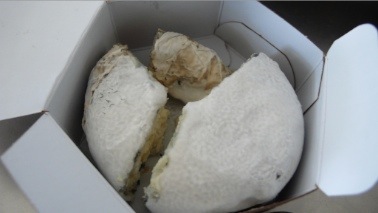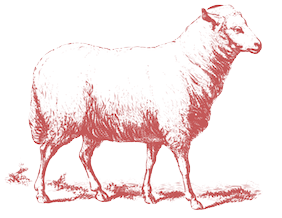 Recently, I stopped by my "other" cheesemonger (not Tim) at Alon's just to take a peak at what was new. Now, I'm not a huge lover of Alon's cheese counter; the folks who run it are polite and reasonably knowledgeable, but the selection and presentation of the cheeses is less interesting and less discriminating than Star's. I've come to the understanding that if it's a cheese I already know, I can get it from Alon's without too much risk, but as of my most recent purchase I have decided that if it's new and different, or if it's a delicate cheese that requires special handling, I stay away. When I was last there, I picked up an intruiging-looking cheese, Shahat. I was drawn by the unusual packaging: an octagonal cardboard box with a minimalist typeface. I was further drawn to it by its mixture of sheep and goat milk, and even further interested by the fact that it is an Israeli cheese; not something one sees everyday, to be sure. From the sturdy packaging, I assumed that these cheesemakers took the handling of their cheese very seriously. Indeed, the back of the box has specific handling and temperature instructions (think the packaging of VB&C's Bonne Bouche). When I got home and opened the box, I found to my great surprise, that the cheese was tightly wrapped in plastic. It had also been in the plastic long enough for the p. candidium to grow into the folds and crevices of the plastic, giving it odd little fins (not a good sign).
Recently, I stopped by my "other" cheesemonger (not Tim) at Alon's just to take a peak at what was new. Now, I'm not a huge lover of Alon's cheese counter; the folks who run it are polite and reasonably knowledgeable, but the selection and presentation of the cheeses is less interesting and less discriminating than Star's. I've come to the understanding that if it's a cheese I already know, I can get it from Alon's without too much risk, but as of my most recent purchase I have decided that if it's new and different, or if it's a delicate cheese that requires special handling, I stay away. When I was last there, I picked up an intruiging-looking cheese, Shahat. I was drawn by the unusual packaging: an octagonal cardboard box with a minimalist typeface. I was further drawn to it by its mixture of sheep and goat milk, and even further interested by the fact that it is an Israeli cheese; not something one sees everyday, to be sure. From the sturdy packaging, I assumed that these cheesemakers took the handling of their cheese very seriously. Indeed, the back of the box has specific handling and temperature instructions (think the packaging of VB&C's Bonne Bouche). When I got home and opened the box, I found to my great surprise, that the cheese was tightly wrapped in plastic. It had also been in the plastic long enough for the p. candidium to grow into the folds and crevices of the plastic, giving it odd little fins (not a good sign).

Here is is after I took the plastic off, notice the fins on the bottom and how it looks like the plastic is still on.
At this point, I knew that the odds for disappointment were getting pretty high. Cutting it open confirmed my bad feeling:
Something crazy happened to this poor cheese. It had about four different textures going on inside, none of which were consistent. In some places it was a dense, dry paste, in others it had an open structure, and in others it looked like it was trying to become creamy, but ended up looking greasy, like the fat was separating from the protein. It was bad. One corner of the cheese looked like the rind had completely died off and the inside of the cheese in that area was discolored and slightly foul to taste. Pretty much all I got out of the cheese was sourness, slight bitterness, and strong ammonia. It was edible, but not altogether pleasant. Interestingly, I opened it back up a couple of weeks later, just to see what, if anything might have happened to it. Indeed it had changed:
 Look at that pretty, soft new p. candidium growth! I mean, the cheese is not any good anymore at all, but it shows very clearly that the rind was being killed by the stifling conditions of plastic wrap.
Look at that pretty, soft new p. candidium growth! I mean, the cheese is not any good anymore at all, but it shows very clearly that the rind was being killed by the stifling conditions of plastic wrap.
This experience is a case-in-point for the critical importance of good packaging and storing. Cheese is a living food. As such, it respirates, i.e. it breathes. If someone wrapped plastic all over your body, you would eventually die. Even if you could still breathe through your nose and mouth, your skin would eventually rot from trapped moisture. This is exactly what happens to cheese, especially high-moisture bloomy and washed-rind cheeses. Gross. I have to wonder whose fault this really was, though. Was it an issue with customs? Is it a regulation that imported cheeses must be wrapped in cellophane? Did Alon's wrap these cheese when it arrived? Why was special "breathable" wrap not used? Who knows? All I know is that this was a sad circumstance for what could have been a lovely cheese. I give it a 2, though it's unfair, really to rate a cheese that has been so abused.

